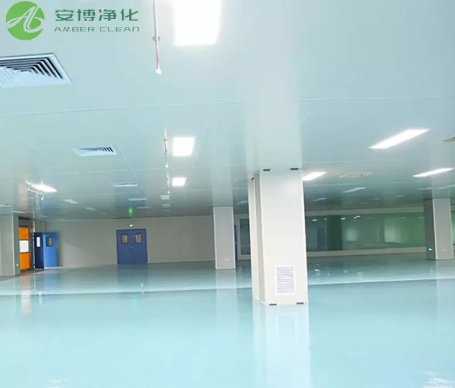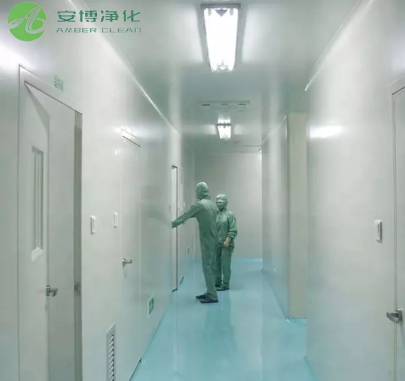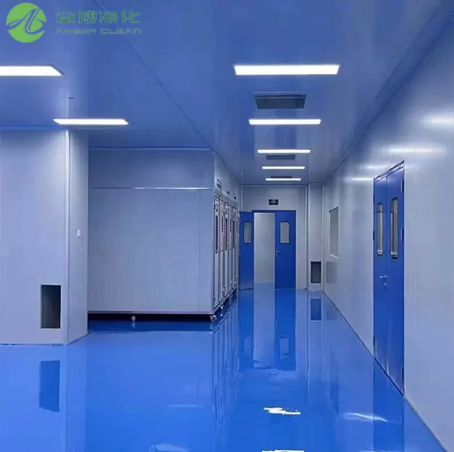- All
- Product Name
- Product Keyword
- Product Model
- Product Summary
- Product Description
- Multi Field Search
Views: 228 Author: Site Editor Publish Time: 2025-08-27 Origin: Site








Cleanroom manufacturing plays a crucial role in industries like pharmaceuticals, medical devices, and microelectronics, ensuring contamination-free environments. But is it better to outsource or manage it in-house?
In this post, we’ll explore the key benefits of in-house cleanroom manufacturing, from improved product quality to cost savings, and why many companies choose to keep it in-house.

In-house clean room manufacturing refers to the practice of managing cleanroom operations internally, within a company's own facility. This ensures total control over contamination, quality, and compliance processes. Unlike outsourced solutions, where third-party providers handle cleanroom services, in-house cleanrooms give businesses direct oversight, ensuring specific standards are maintained throughout production.
One critical aspect of in-house cleanrooms is their compliance with ISO standards, particularly ISO 14644. This standard outlines the classifications of cleanrooms based on the concentration of airborne particles, helping businesses select the appropriate environment for their manufacturing needs.
Clean room manufacturing is essential for industries where precision and product quality are non-negotiable. Industries like pharmaceuticals, medical devices, and biotechnology rely heavily on cleanroom environments to maintain product integrity and safety.

Cleanrooms effectively control a wide range of contaminants, such as dust, bacteria, and microbes, which could jeopardize the quality of sensitive products. By creating controlled conditions, cleanrooms help ensure products meet strict regulatory standards, such as those set by the FDA and ISO.
Examples of industries needing cleanroom environments include:
· Pharmaceuticals: To prevent contamination in drug production.
· Medical Devices: Ensuring sterility and safety of medical instruments.
· Biotechnology: Protecting sensitive biological materials from contamination.
These industries must manage contaminants such as airborne particles, microbes, and static, which cleanrooms are specifically designed to control.
In-house clean rooms play a vital role in preventing contamination during manufacturing. By maintaining strict control over the environment, they ensure that products are free from harmful particles or microbes. This leads to higher product quality, fewer defects, and more consistent results across different production runs.
For instance, in medical device sterilization, cleanroom environments prevent contaminants from affecting devices, ensuring safety and functionality. Similarly, in pharmaceutical manufacturing, cleanrooms ensure that drugs are free from pollutants, maintaining their effectiveness.
Adhering to industry standards is essential for companies aiming for product approval and market access. In-house cleanrooms make it easier to meet stringent regulatory requirements, such as FDA, GMP, and ISO 13485. These standards demand specific cleanliness levels, which in-house cleanrooms can consistently maintain.
A controlled in-house environment simplifies the documentation process, ensuring that all cleanliness standards are met during production. This often leads to faster product approvals and smoother market entry.
While setting up an in-house cleanroom can be an initial investment, it provides long-term savings by reducing scrap, rework, and downtime caused by contamination issues. By managing processes internally, companies can optimize the use of raw materials and energy, reducing waste and lowering overall production costs.
For example, companies with in-house cleanrooms have significantly cut costs in production by minimizing contamination risks, reducing the need for product recalls or rework.
In-house cleanroom environments protect workers by keeping hazardous materials and airborne contaminants in check. This reduces exposure to toxic substances and ensures a safer work environment. With strict safety protocols, such as proper gowning procedures and air filtration, employees are shielded from risks associated with hazardous drugs and chemicals.
The controlled atmosphere within the cleanroom contributes to the overall health and safety of personnel.
In-house cleanroom manufacturing gives companies a distinct edge in the marketplace. By ensuring consistent quality and adherence to industry standards, companies can attract customers who prioritize reliability and product safety. Showcasing cleanroom capabilities in marketing materials and presentations can help enhance a business's reputation as a trusted producer of high-quality products.
Investing in cleanroom manufacturing not only improves product quality but also positions a company as a leader in its industry.
In-house cleanrooms play a crucial role in driving innovation in product development and research. By offering a controlled environment, these cleanrooms allow companies to experiment, refine, and test new technologies with minimal contamination risks. This fosters the creation of cutting-edge products and technologies.
For example, in medical device manufacturing, cleanrooms have been essential for developing sterile devices, such as surgical implants and diagnostic tools. Similarly, in the biopharmaceutical industry, cleanrooms have supported the development of life-saving drugs by preventing contamination during manufacturing.
Cleanrooms also enable R&D teams to conduct experimental procedures that require strict environmental controls. Whether it's testing new materials or developing novel therapeutic techniques, cleanroom environments ensure that experiments are performed with high precision and reliability.
One of the biggest advantages of in-house cleanroom manufacturing is the ability to tailor cleanroom conditions to meet the unique needs of various industries. For instance, microelectronics manufacturing requires cleanrooms that manage static electricity and particle contamination. In biopharma, specific conditions for temperature, humidity, and air quality are necessary to maintain the stability of sensitive biological products.
In-house cleanrooms can be customized to regulate factors like temperature, humidity, and air filtration systems to create the ideal conditions for different manufacturing processes. This level of flexibility ensures that businesses can produce high-quality products that meet industry-specific standards.
Setting up an in-house cleanroom involves several upfront costs, including construction, equipment, and maintenance. These expenses can be significant, especially for specialized environments like ISO-certified cleanrooms. The initial investment includes building the facility to meet specific cleanliness standards, purchasing air filtration systems, and outfitting the space with the necessary tools and technology.
However, the initial investment can pay off in the long run. In-house cleanrooms reduce waste and scrap by minimizing contamination risks, leading to fewer product recalls and rework. This increases efficiency and improves overall product yield. Additionally, companies can benefit from tax deductions related to capital equipment and depreciation, further offsetting some of the setup costs.
While the initial investment is crucial, managing ongoing operational costs is equally important. Companies must balance cleanroom quality with the need to keep operational expenses under control. Key factors influencing these costs include energy consumption, staff training, and material handling.
For instance, energy-efficient HVAC systems and LED lighting can help reduce energy costs, while proper training ensures staff follows strict protocols without requiring frequent retraining. Additionally, automating material handling within the cleanroom can optimize processes, reducing human error and operational costs.
An example of efficient cleanroom manufacturing is implementing lean principles, which optimize workflows while maintaining high-quality standards. This ensures that every part of the process is as cost-effective as possible, maximizing both output and savings.
The initial cost of setting up an in-house cleanroom can be substantial. Expenses include the construction of specialized facilities, HVAC systems, and high-efficiency air filtration systems. These investments are necessary to meet the specific cleanliness standards required for industries like pharmaceuticals and medical devices.
Beyond the setup, ongoing maintenance costs can be significant. Cleanrooms require continuous monitoring to maintain ISO certification, which includes regular audits and recalibration of equipment. This can be costly, as maintaining an environment that meets regulatory standards like ISO 14644 demands constant attention to detail.
Cleanroom environments demand a specialized workforce capable of adhering to strict hygiene and operational protocols. Training staff to ensure proper gowning, sanitation, and compliance with industry standards is essential. This training can be time-consuming and costly, especially when it needs to be frequently updated to meet evolving standards.
Additionally, companies may face higher hiring costs for personnel with the expertise to manage cleanroom operations effectively. This specialized workforce ensures high operational standards but also adds to overall labor costs.
One of the challenges in implementing cleanroom manufacturing is dealing with space limitations. Cleanrooms need to meet specific requirements for airflow, temperature, and humidity, often necessitating a dedicated space within a facility. This can be a challenge for businesses looking to convert existing facilities into cleanroom spaces, as it may require significant adjustments.
The resource requirements are also substantial. Cleanrooms rely on advanced HVAC systems, air filtration, and specialized equipment, all of which consume considerable energy. Balancing these needs with the facility’s operational space and available resources is a key challenge in maintaining an efficient cleanroom environment.
To ensure your cleanroom manufacturing meets the highest standards, achieving ISO 14644 certification is essential. The first step is designing and constructing the cleanroom to meet the required cleanliness levels for your industry. This includes setting up proper air filtration, temperature, and humidity control systems.
After setting up the cleanroom, ongoing testing and maintenance are crucial to maintaining ISO compliance. Regular air particle testing, surface contamination checks, and equipment calibration are necessary to validate the cleanroom’s performance. Environmental monitoring is essential to ensure continuous control of contaminants and airflow to keep the space within certification limits.
Designing an efficient cleanroom is key to minimizing contamination risks and improving productivity. To optimize workflow, arrange equipment and workstations logically to reduce unnecessary movement and contamination. This design should also facilitate easy access to essential tools and materials while maintaining cleanliness.
Another important aspect is air pressure management. Ensuring proper airflow helps prevent the intrusion of contaminants from non-clean zones. Adequate ventilation is essential for maintaining both environmental conditions and worker safety, making sure the cleanroom’s air stays purified and the work environment is comfortable.
Incorporating lean manufacturing principles into cleanroom operations can significantly enhance efficiency. Lean techniques focus on reducing waste, minimizing downtime, and eliminating unnecessary movement within cleanroom spaces. For example, by streamlining production flows and eliminating bottlenecks, businesses can maintain a consistent pace without compromising cleanliness.
Optimizing the use of materials, minimizing inventory handling, and improving resource allocation are all ways lean manufacturing can boost the productivity and cost-effectiveness of in-house cleanrooms.
In-house cleanroom manufacturing provides several key benefits, such as enhanced product quality, greater regulatory compliance, and cost savings over time. It helps reduce defects, ensures high-quality outputs, and meets stringent industry standards.
When deciding to invest in a cleanroom, consider factors such as your company's size, the complexity of your products, and the regulatory demands of your industry. Industries like pharmaceuticals, medical devices, and microelectronics often benefit the most from cleanroom manufacturing.
While the initial investment can be high, the long-term savings in waste reduction, better efficiency, and improved product consistency can make it a worthwhile choice. In the right circumstances, investing in cleanroom manufacturing can provide your business with a significant competitive advantage.

Q: What is in-house cleanroom manufacturing?
A: In-house cleanroom manufacturing involves managing cleanroom operations within a company's facility, ensuring strict control over contamination and regulatory compliance.
Q: What are the benefits of in-house cleanroom manufacturing?
A: Key benefits include enhanced product quality, improved regulatory compliance, long-term cost savings, increased operational efficiency, and a competitive market advantage.
Q: How does in-house cleanroom manufacturing improve product quality?
A: In-house cleanrooms minimize contamination risks, leading to fewer defects, more consistent production, and higher-quality products, especially in sensitive industries like pharmaceuticals and medical devices.
Q: What industries benefit the most from in-house cleanroom manufacturing?
A: Industries like pharmaceuticals, medical devices, biotechnology, and microelectronics rely heavily on cleanroom manufacturing to ensure product safety and meet regulatory standards.
Q: What are the initial and ongoing costs of setting up an in-house cleanroom?
A: The initial investment involves construction, equipment, and certification costs. Ongoing expenses include maintenance, operational costs, and regular testing to maintain ISO certification.
Q: How do I ensure my cleanroom meets regulatory standards?
A: Achieving and maintaining ISO 14644 certification and regularly monitoring environmental factors such as particle control and airflow are essential for staying compliant.
Q: Can in-house cleanroom manufacturing reduce costs in the long term?
A: Yes, it can reduce costs by minimizing waste, scrap, rework, and downtime, while optimizing resource use, resulting in long-term savings.
Q: How can lean manufacturing principles be applied to cleanroom operations?
A: Lean techniques reduce waste, streamline production, and improve efficiency within the cleanroom, leading to faster production times and cost savings.